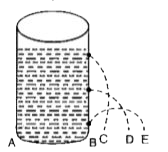Explain why, water comes out more slowly from an upstairs tap than from a similar tap downstairs.
To explain why water comes out more slowly from an upstairs tap than from a similar tap downstairs, we can break down the explanation into several steps:
Step 1: Understanding Pressure
- Pressure is defined as the force exerted per unit area. In fluids, pressure is influenced by the depth of the fluid.
Step 2: Pressure and Altitude
- As we move to higher altitudes (like an upstairs tap), the pressure decreases. This is because there is less water above to exert pressure downwards.
Step 3: Pressure and Depth
- Conversely, when we are at a lower altitude (like a downstairs tap), the pressure increases with depth. This is because there is more water above the tap, which exerts more pressure.
Step 4: Comparing the Taps
- In our scenario, the downstairs tap experiences higher pressure due to the greater depth of water above it. This higher pressure pushes the water out of the tap more forcefully.
Step 5: Conclusion
- Therefore, the water comes out more slowly from the upstairs tap because it is under lower pressure compared to the downstairs tap, where the pressure is higher due to the greater depth of water.
Final Statement
- In summary, the difference in water flow rate from the upstairs and downstairs taps is primarily due to the difference in water pressure caused by their respective altitudes.
---
- Pressure is defined as the force exerted per unit area. In fluids, pressure is influenced by the depth of the fluid.
- As we move to higher altitudes (like an upstairs tap), the pressure decreases. This is because there is less water above to exert pressure downwards.
- Conversely, when we are at a lower altitude (like a downstairs tap), the pressure increases with depth. This is because there is more water above the tap, which exerts more pressure.
- In our scenario, the downstairs tap experiences higher pressure due to the greater depth of water above it. This higher pressure pushes the water out of the tap more forcefully.
- Therefore, the water comes out more slowly from the upstairs tap because it is under lower pressure compared to the downstairs tap, where the pressure is higher due to the greater depth of water.
- In summary, the difference in water flow rate from the upstairs and downstairs taps is primarily due to the difference in water pressure caused by their respective altitudes.
Topper's Solved these Questions
Similar Questions
Knowledge Check
Water falls from a tap, down the streamline
AArea decreasesBArea increasesCVelocity remains sameDArea remains sameRegion of root from base tip in a tap root are
AMaturation zone (MZ)-Cell division zone (CDZ)-Elongation zone (EZ)BMZ-EZ-CDZCCDZ-EZ-MZDEZ-CDZ-MZFrom acitve hydathodes, the water comes out by
AOsmotic pressureBSecreted by force developed within cells themselvesCBy root pressureDNone of the above
Explain why water begins to flow towards the ground as soon as we open a tap.
View SolutionExplain why sodium is more reactive than lithium.
View SolutionExplain why HF is less viscous than water?
View SolutionWhy burns from steam are more serious than those from boling water?
View SolutionThree tiny holes are made in an empty can at different levels, one over the other.

They are temporarily closed with an adhesive tap and then the can is filled with water. As the tapes are pulled out, water starts flowing out from the holes. It is observed that water flowing out from the lowest hole goes farthest and that from the uppermost hole nearest to the can (BE > BD > BC). Why? What does this experiment show ?
View Solution
